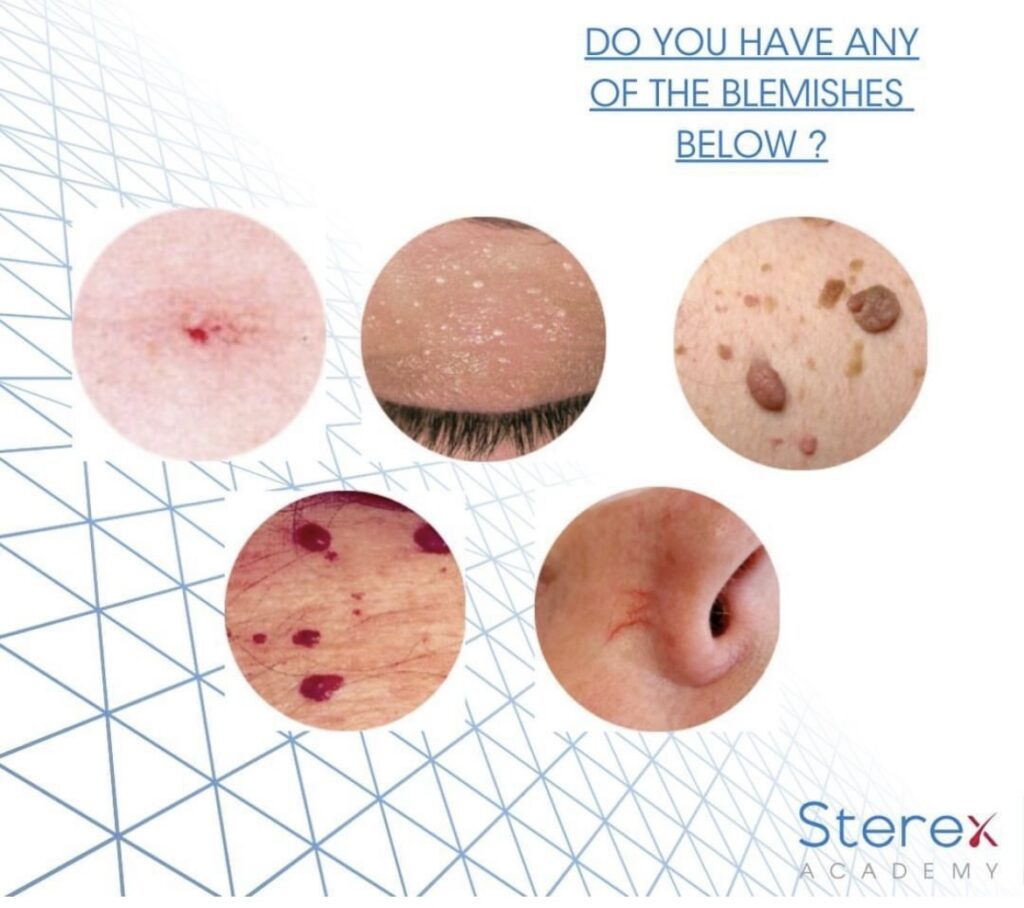Blemish Treatment, Removal and Process

Using an advanced electrolysis method, the treatments involve using a pen-like device with a very fine probe. This device emits short wave diathermy and cauterises the blemish which is then either fully removed on the day of treatment or will disperse naturally over a short period.
Varied techniques are used depending on the blemish being treated. Patients may experience mild discomfort, healing time varies but it is usually within a minimum of 10 days.
Price List:
- Single Blemish from £80
- 15 minutes £130
- 30 minutes £200
- Mole reduction / removal
- Single from £120
- 15 minutes £160
- 30 minutes £220
We can treat the following blemishes:
- Skin tags,
- Blood spots,
- Facial thread veins,
- Seborrhoeic keratosis or pigmented age spots,
- Warts and verrucas,
- Milia or xanthelasma on the eye lids,
- Sebaceous hyperplasia,
- and syringoma.
Skin Tags
Benign growth of skin, commonly found in areas of friction such as the underarms, neck, eyes and chest area. They usually appear to have a stalk-like attachment to the skin with a round, fleshy bulb tip. They also vary in size but tend to be very small to start and can sometimes grow to the size of a large pea. These are quickly and effectively removed on the day of treatment using the advanced electrolysis method.
Blood Spots, Campbell de Morgan,, Cherry Angiomas
These are small benign red blood filled blemishes found on the body. They can be found anywhere but are usually more commonlv found on the torso or sun-exposed areas. These vary in size and can be small and flat to larger and raised. Factors that contribute to their appearance include sun exposure, genetics, and age. Using diathermy these can be cauterised and therefore effectively dispersed throughout the body.
Thread Veins
These are vessels that vary in size. Due to various factors, Thread Veins can become permanently dilated, causing them to appear more prominently. The factors contributing to this is sun damage, ageing, hormones, trauma and exposure to extreme weather conditions. These can be found anywhere but tend to be most troublesome
on the cheeks, chin, and nose.
The diathermy emitted causes cauterisation of the blood, therefore, causing a breakdown of the treated vessel. Multiple treatments may be required for full effectiveness.
Milia
These are small white, hard round spots which lie superficially under the skin which contain keratin. It is suspected these occur when the skin is dehydrated. These are mainly found on the face and more specifically around the eye area. These can be easily treated with minimal effect on the skin using diathermy.
Seborrheic Keratosis
These can also be known as seborrheic or senile warts. Although Seborrheic Keratosis can be classed as a form of a wart, they differentiate by the fact they are not contagious or viral like the common wart.
They have a dry/rough, scaly, matt appearance and can range from skin colour to dark brown. They appear to look like a stretched mole and usually form in groups.
They appear with age but are usually hereditary too. These can be found anvwhere but are more commonly found on the torso and face. Various techniques can be utilised to remove them effectively.
Warts and Verrucas
Warts and Verrucas are caused by the Human Papilloma Virus (HPV) which spread viral contact from person to person, including communal areas such as gyms, swimming baths etc. They are rough to the touch with black dots (the blood supply) visible in the centre of the cluster. To treat these, the diathermy is used to trigger the bodies healing response to the virus to therefore treat warts/verrucas. The effectiveness of this treatment varies for all, but 1-3 treatments are needed to try to achieve the best outcome.
